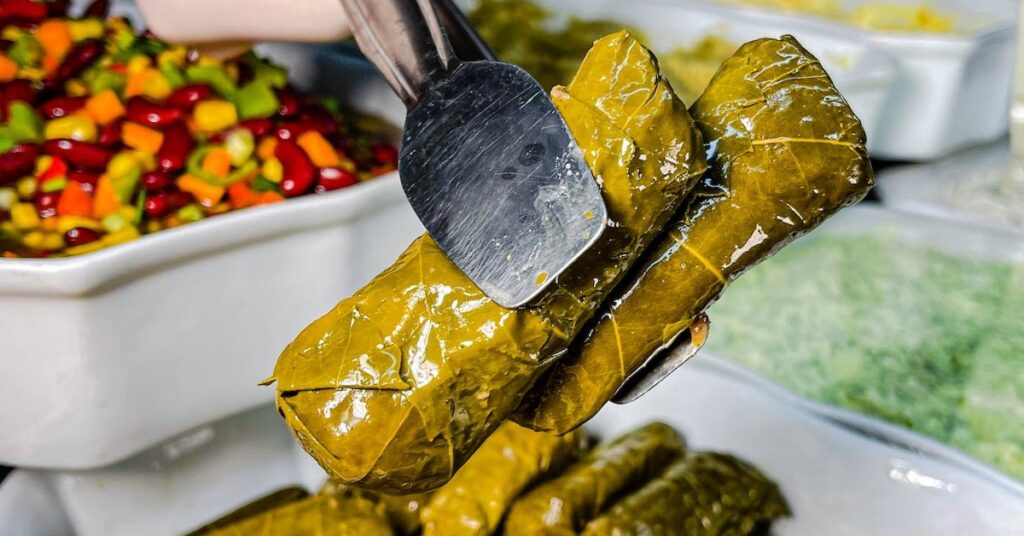Greek cuisine, celebrated for its vibrant flavors and communal dining style, offers a delightful array of dishes known as Greek Meze Appetizers. These appetizers or small plates are a cornerstone of Greek culinary tradition, embodying the spirit of sharing and socializing that defines Greek meals. This journey through the evolution of Greek meze not only explores its rich history from ancient times but also highlights popular dishes and their modern adaptations.
The Historical Roots of Greek Meze Appetizers
The tradition of meze dates back to ancient Greece, where the concept of symposium—an assembly of people enjoying food and conversation—played a central role in society. Meze Appetizers served at these gatherings wasn’t just about sustenance but also about fostering community and dialogue. This tradition continued through the Byzantine and Ottoman periods, evolving with cultural influences and regional ingredients, resulting in the diverse array of meze seen in Greek cuisine today.

Iconic Greek Meze Appetizers Dishes
Several meze dishes have become emblematic of Greek cuisine, each with its own unique story and flavor profile:
- Tzatziki: This refreshing yogurt and cucumber dip, seasoned with garlic and dill, is a staple on any Greek table, perfect for cooling the palate alongside spicy dishes or simply enjoyed with warm pita bread.
- Spanakopita: This beloved pastry features a flaky filo crust stuffed with spinach and feta cheese, combining earthy and tangy flavors in every bite.
- Dolmades: Stuffed grape leaves filled with a mixture of rice, herbs, and often pine nuts or ground meat, dolmades are a testament to the ingenuity of Greek cooks to wrap flavorful ingredients in bite-sized packages.
- Greek Salad: Known in Greece as Horiatiki, this salad is a colorful celebration of Greek agriculture, featuring tomatoes, cucumbers, onions, olives, and a slab of feta cheese, all drizzled with olive oil and sprinkled with oregano.
- Saganaki: Typically made with kefalotyri or kasseri cheese, this pan-fried cheese dish is often flambeed in brandy tableside, adding drama to its deliciousness.
- Taramosalata: A creamy, salty dip made from fish roe, olive oil, lemon juice, and a starchy base of bread or potatoes, offering a taste of the sea.
- Melitzanosalata: A smoky eggplant dip that embodies the essence of grilled vegetables, typically seasoned with garlic, lemon, and olive oil.
Traditional Pairings with Greek Meze Appetizers
The flavors of Greek meze are enhanced by traditional beverages:
- Ouzo: This anise-flavored liqueur is synonymous with Greek culture, often served with ice or water to accompany spicy or salty dishes.
- Retsina: This resin-infused wine has been a Greek staple for millennia, its unique flavor profile complementing the robust tastes of meze.
- Tsipouro: A potent grape pomace brandy that is typically consumed alongside hearty meze options to balance their richness.
- Greek Wines: Varieties like Assyrtiko, Agiorgitiko, and Xinomavro provide the perfect accompaniment to meze, each enhancing the dishes’ flavors with their distinct characteristics.
Preparing Greek Meze Appetizers at Home
Creating Greek meze appetizers in your own kitchen is both fulfilling and a great way to bring people together. With simple, fresh ingredients and traditional recipes, anyone can recreate the essence of Greek dining. From homemade tzatziki to hand-rolled dolmades, the process of preparing these dishes is as enjoyable as eating them.
Conclusion
Greek meze is more than just food; it is a culinary tradition steeped in history, flavored with the richness of the Mediterranean, and shared with joy. Whether enjoyed in a bustling Greek taverna or in the comfort of your home, meze offers a taste of Greek heritage that is timeless and unforgettable. As you explore the world of Greek meze, you immerse yourself in a tradition that celebrates life, friendship, and good food.
Frequently Asked Questions About Greek Meze Appetizers
What exactly is Greek meze? Greek meze refers to a variety of small dishes served as appetizers or as part of a larger meal in Greece. These dishes are designed to be shared among diners and are often accompanied by wine or spirits like ouzo. Meze can range from dips and vegetables to seafood and grilled meats.
How is meze appetizers different from tapas? While both meze and tapas are collections of small dishes, they originate from different cultures and culinary traditions. Meze is central to Greek and Middle Eastern cuisines, emphasizing communal and leisurely dining, often accompanied by alcohol. Tapas, on the other hand, are Spanish in origin and were traditionally small snacks eaten with drinks. Over time, tapas have evolved into a more comprehensive dining experience.
What are some must-try meze dishes for beginners? For those new to Greek cuisine, some must-try meze appetizers dishes include:
- Tzatziki: A refreshing yogurt and cucumber dip with garlic.
- Spanakopita: Phyllo pastry filled with spinach and feta cheese.
- Dolmades: Grape leaves stuffed with rice and herbs.
- Saganaki: Seared Greek cheese, often flambéed and served hot.
- Taramosalata: A savory dip made from fish roe.
Is Greek meze served at every meal?
Meze is not typically served at every meal but is common in social settings or at restaurants, especially as starters or during leisurely meals that encourage sharing and conversation.
Can Greek meze appetizers be made at home?
Yes, many Greek meze dishes are simple to prepare at home with basic ingredients and a few key spices. Dishes like tzatziki, Greek salad, and various dips are particularly easy to make and provide a good starting point for beginners.
Are there vegetarian options in Greek meze appetizers?
Absolutely! Greek cuisine offers an abundance of vegetarian meze options. Many dishes, like tzatziki, melitzanosalata (eggplant dip), and gigantes (baked giant beans), are naturally vegetarian. Additionally, dishes such as spanakopita can be modified to exclude meat, focusing instead on the rich flavors of vegetables and herbs.
How should Greek meze appetizers be served for an authentic experience?
For an authentic Greek meze experience, serve a variety of dishes at room temperature or warm, as appropriate. Arrange the meze on a large platter or in small individual plates and serve with plenty of fresh bread or pita for dipping. Don’t forget to include a selection of Greek wines or spirits like ouzo or tsipouro to complement the flavors of the meze.
What drinks pair well with Greek meze Appetizers?
Traditional Greek drinks such as ouzo, retsina, and tsipouro are excellent with meze, as they complement the robust flavors of the dishes. Wine lovers might also enjoy pairing meze with Greek white wines like Assyrtiko or reds such as Xinomavro, depending on the specific dishes served.
Serving Greek meze appetizers is as much about the presentation and variety as it is about the flavors. Here’s how you can serve Greek meze to capture the essence of a traditional Greek dining experience:
- Variety is Key: Include a wide range of dishes to offer different textures and flavors. Common meze items include tzatziki, spanakopita, dolmades, saganaki, taramosalata, and Greek salad. Aim for a balance of meat, seafood, vegetables, and dips.
- Use Small Plates: Meze is traditionally served on small plates or in small bowls. This not only enhances the visual appeal but also makes sharing easier, which is at the heart of meze dining.
- Provide Plenty of Bread: Offer plenty of fresh, warm bread or pita. Bread is essential for scooping up dips and sauces and complements the various flavors of the meze.
- Arrange Artfully: Arrange the dishes on a large platter or several small platters spread across the table. Garnish with lemon slices, fresh herbs, and a drizzle of olive oil to make the dishes vibrant and appetizing.
- Include Drinks: Pair the meze with traditional Greek drinks. Ouzo, with its anise-flavored liqueur, is a classic choice. You can also serve Greek wines, such as Retsina or a crisp Assyrtiko, which complement the rich flavors of the meze.
- Encourage Sharing: Place the meze appetizers in the center of the table to encourage communal eating. Meze is meant to be shared, fostering conversation and a relaxed dining experience.
- Keep It Casual: The atmosphere should be informal and relaxed. Meze is not just about eating; it’s about enjoying time with friends and family.
By following these tips, you can create a traditional Greek meze experience that delights the senses and brings people together, just as it’s meant to.
These FAQs provide a glimpse into the delightful world of Greek meze, offering suggestions for preparation and enjoyment that can bring a taste of Greece into your dining experience, whether at home or in a restaurant.
- Tzatziki Sauce1.
- My Greek Dish: Offers authentic, locally sourced Greek recipes, and traditional dishes like Gemista (Greek Stuffed Tomatoes and Peppers)2.
- Greek Chef Diane Kochilas: Features Mediterranean and Ikarian longevity recipes curated by Greek Chef Diane Kochilas, host of My Greek Table on PBS3.
- Lemon & Olives: Explores Greek food and culture with a modern twist, offering recipes for staples like Tzatziki and Souvlaki alongside modern Greek dishes4.





Posts from Chef on a Bike with their titles hyperlinked:
- Delicious Greek Hummus Recipe: Discover the secrets to making a creamy and flavorful Greek hummus.
- Baklava: Greek Walnut & Pistachio Cake: Learn how to make traditional Greek Baklava with walnuts and pistachios.
- Greek Festival 2024: Get ready for the upcoming Greek Festival with details and highlights.
- Beef Souvlaki: Juicy and Tender Chunks: A guide to making the perfect Greek beef souvlaki.
- Mediterranean Diet: A Healthy Choice: Explore the benefits of the Mediterranean diet.
- Greek Easter Kokoretsi: Cooking Methods & Recipe: Traditional methods and recipes for Greek Easter Kokoretsi.
- Manuka Honey Health Benefits: Learn about the health benefits of Manuka honey.
- Find Vegetarian Recipes: A collection of delicious vegetarian Greek recipes.
- Greek Christmas Traditions: Discover how Christmas is celebrated in Greece.
- Mediterranean Greek Salad: A Refreshing Delight: Make a refreshing Greek salad with this simple recipe.
- Greek Kataifi Dessert: A traditional Greek dessert made with shredded phyllo dough and nuts.
- Best of Greek Cheeses: Explore the diverse and delicious world of Greek cheeses.
- Rare Ikaria Honey: Learn about the unique and rare honey from Ikaria.
- Greek Yogurt Benefits: Discover the health benefits of Greek yogurt.
- Greek Food Festivals and Traditions: A guide to the various food festivals and culinary traditions in Greece.
- Greek Language, Culture, and Cuisine: An exploration of the Greek language, culture, and cuisine.
- Greek Cuisine: Tradition of Greek Breads: Learn about the traditional breads of Greek cuisine.
- Greek Koulouri: Sesame Bread Rings: Make traditional Greek sesame bread rings.
- Succulent Keftedes: Greek Meatballs Meze: A recipe for making succulent Greek meatballs.
- Greek Egg Dishes: A Protein-Packed Start: Protein-packed Greek egg dishes for a hearty start to the day.


















